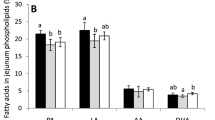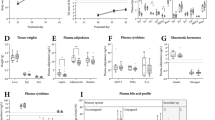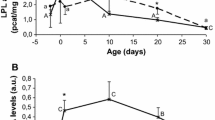Abstract
This study evaluated the effects of dietary supple-mentation with ψ-linolenic acid (GLA, 18∶3n−6) and docosahexaenoic acid (DHA, 22∶6n−3) on the fatty acid composition of the neonatal brain in gastrostomized rat pups reared artificially from days 5–18. These pups were fed rat milk substitutes containing fats that provided 10% linoleic acid and 1% α-linolenic acid (% fatty acids) and, using a 2×3 factorial design, one of two levels of DHA (0.5 and 2.5%), and one of three levels of GLA (0.5, 1.0, and 3.0%). A seventh artificially reared groups served as a reference group and was fed 0.5% DHA and 0.5% arachidonic acid (AA, 20∶4n−6); these levels are within the range of those found in rat milk. The eighth group, the suckled control group, was reared by nursing dams fed a standard American Institute of Nutrition 93M chow. The fatty acid composition of the phosphatidylethanolamine, phosphatidyl-choline, and phosphatidylserine/phosphatidylinositol membrane fractions of the forebrain on day 18 reflected the dietary composition in that high levels of dietary DHA resulted in increases in DHA but decreases in 22∶4n−6 and 22∶5n−6 in brain. High levels of GLA increased 22∶4n−6 but, in contrast to previous findings with high levels of AA, did not decrease levels of DHA. These results suggest that dietary GLA, during development, differs from high dietary levels of AA in that it does not lead to reductions in brain DHA.
Similar content being viewed by others
Abbreviations
- AA:
-
arachidonic acid
- AR:
-
artificial rearing
- DHA:
-
docosahexaenoic acid
- GLA:
-
ψ-linolenic acid
- LA:
-
linoleic acid
- ECP:
-
long-chain polyunsaturated fatty acid
- LN:
-
linolenic acid
- PC:
-
phosphatidylcholine
- PE:
-
phosphatidylethanolamine
- PS/PI:
-
phosphatidylserine/phosphatidylinositol
References
Innis, S. (1991) Essential Fatty Acids in Growth and Development, Prog. Lipid Res. 30, 39–103.
Edmond, J., Higa, T.A., Korsak, R.A., Bergner, E.A., and Lee, W.N. (1998) Fatty Acid Transport and Utilization for the Developing Brain. J. Neurochem. 70, 1227–1234.
Marbois, B.N., Ajie, H.O., Korsak, R.A., Sensharma, D.K., and Edmond, J. (1992) The Origin of Palmitic Acid in Brain of the Developing Rat, Lipids 27, 587–592.
Voss, A., Reinhart, M., Sankarappa, S., and Sprecher, H. (1991) The Metabolism of 7.10,13,16,19-Docosapentaenoic Acid to 4,7,10,13,16,19-Docosahexaenoic Acid in Rat Liver Is Independent of a 4-Desaturase, J. Biol. Chem. 266, 1995–20000.
Bazan, N.G., Rodriguez de Turco, E.B., and Gordon, W.C. (1994) Docosahexaenoic Acid Supply to the Retina and Its Conservation in Photoreceptor Cells by Active Retinal Pigment Epithelium-Mediated Recycling, World Rev. Nutr. Diet, 75, 120–123.
Moore, S.A., Yoder, E., Murphy, S., Dutton, G.R., and Spector, A.A. (1991) Astrocytes, Not Neurons, Produce Docosa-hexaenoic Acid (22∶6 omega-3) and Arachidonic Acid (20∶4 omega-6), J. Neurochem. 56, 518–524.
Bourre, J.M., Dumont, O.S., Piciotti, M.J., Pascal, G.A., and Durand, G.A. (1992) Dietary Alpha-Linolenic Acid Deficiency in Adult Rats for Seven Months Does Not Alter Brain Docosa-hexaenoic Acid Content, in Contrast to Liver, Heart and Testes, Biochim. Biophys. Acta 1124, 119–122.
Ward, G.R., and Wainwright, P.E. (1998) The Contribution of Animal Models to Understanding the Role of Fats in Infant Nutrition, in Lipids in Infant Nutrition, (Huang, Y.-S., and Sinclair, A.J., eds.), pp. 39–62, AOCS Press, Champaign.
Patel, M.S., and Vadlamudi, S. (1994) Artificial Rearing of Rat Pups: Implications for Nutrition Research, Annu. Rev. Nutr. 14, 21–40.
West, J.R. (1993) Use of Pup in the Cup Model to Study Brain Development, J. Nutr. 188, 1312–1314.
Ward, G., Woods, J., Reyzer, M., and Salem, N., Jr. (1996) Artificial Rearing of Infant Rats on Milk Formula Deficient in (n-3) Essential Fatty Acids: A Rapid Method for the Production of Experimental n-3 Deficiency, Lipids 31, 71–77.
Woods, J., Ward, G., and Salem, N., Jr. (1996) Is Docosahexaenoic Acid Necessary in Infant Formula: Evaluation of High Linolennate Diets in the Neonatal Rat? Rediatr. Res. 40, 687–694.
Ward, G.R., Huang, Y.-S., Bobik, E., Xing, H.-C., Mutsaers, L.. Auestad, N., Montalto, M., and Wainwright, P.E. (1998) Long-Chain Polyunsaturated Fatty Acid Levels in Formulae Influence Deposition of Docosahexaenoic Acid and Arachidonic Acid in Brain and Red Blood Cells of Artificially Reared Neonatal Rat Pups, J. Nutr. 128, 2473–2487.
Wainwright, P., Xing, H.-C., Ward, G., Huang, Y.-S., Bobik, E., Auestad, N., and Montalto, M. (1999) Water Maze Performance Is Unaffected in Artificially Reared Rats Fed Diets Supplemented with Arachidonic Acid and Docosahexaenoic Acid J. Nutr. 129, 1079–1089.
Wainwright, P.E., Xing, H.-C., Mutsaers, L., McCutcheon, D., and Kyle, D. (1997) Arachidonic Acid Offsets the Effects on Mouse Brain and Behavior of a Diet with a Low (n−6)∶(n−3) Ratio and Very High Levels of Docosahexaenoic Acid, J. Nutr. 127, 184–193.
Gibson, R.A., Neumann, M.A., and Makrides, M. (1998) The Effects of Diets Rich in ψ-Linolenic Acid on Plasma Fatty Acid Profiles in Term Infants, in Lipids in Infant Nutrition (Huang, Y.-S., and Sinclair, A.J., eds.) pp. 19–28, AOCS Press, Champaign.
Wainwright, P.E., Huang, Y.-S., Bulman-Fleming, B., Dalby, D., Mills, D.E., Redden, P., and McCutcheon, D. (1992) The Effects of Dietary n-3/n-6 ratio on Brain Development in the Mouse: A Dose Response Study with Long-Chain n−3 Fatty Acids, Lipids 27, 98–103.
Mills, D.E., Ward, R.P., and Huang, Y.-S. (1990) Fatty Acid Composition of Milk from Genetically Normotensive and Hypertensive Rats, J. Nutr. 120, 431–435.
Reeves, P.G., Nielsen, F.H., and Fahey, G.C., Jr. (1993) AIN-93 Purified Diets for Laboratory Rodents: Final Report of the American Institute of Nutrition Ad Hoc Writing Committee on the Reformulation of the AIN-76A Rodent Diet, J. Nutr. 123, 1939–1951.
Folch, J., Lees, M., and Sloane-Stanley, G.H. (1957) A Simple Method for the Isolation and Purification of Total Lipids from Animal Tissues, J. Biol. Chem. 226, 497–509.
Morrison, W.R., and Smith, L.M. (1964) Preparation of Fatty Acid Methyl Esters and Dimethylacetals from Lipids with Boron Trifluoride-Methanol, J. Lipid Res. 5, 600–608.
Cody, R.P., and Smith, J.K. (1991) Applied Statistics and the SAS Programming Language, Prentice-Hall, Englewood Cliffs.
Wainwright, P.E., Huang, Y.-S., Bulman-Fleming, B., Mills, D.E., Redden, P., and McCutcheon, D. (1991) The Role of n−3 Essential Fatty Acids in Brain and Behavioral Development. A Cross Fostering Study in the Mouse, Lipids 26, 37–45.
Wainwright, P.E., Huang, Y.-S., Simmons, V., Mills, D.E., Ward, R.P., Ward, G.R., Winfield, D., and McCutcheon, D. (1990) Effects of Prenatal Ethanol and Long-Chain n−3 Fatty Acid Supplementation on Development in Mice. 2. Fatty Acid Composition of Brain Membrane Phospholipids, Alcohol Clin. Exp. Res. 14, 413–420.
Huang, M.C., and Craig-Schmidt, M. (1996) Arachidonate and Docosahexaenoate Added to Infant Formula Influence Fatty Acid Composition and Subsequent Eicosanoid Production in Neonatal Pigs, J. Nutr. 126, 2199–2208.
Jumpsen, J.J., Lein, E.L., Goh, Y.K., and Clandinin, M.T. (1997) During Neuronal and Glial Cell Development Diet (n−6) to (n−3) Fatty Acid Ratio Alters the Fatty Acid Composition of Phosphatidylinositol and Phosphatidylserine, Biochim. Biophys. Acta 1347, 40–50.
Jumpsen, J.J., Lein, E.L., Goh, Y.K., and Clandinin, M.T. (1997) Small Changes of Dietary (n−6) and (n−3) Fatty Acid Content Ratio Alter Phosphatidylethanolamine and Phosphatidylcholine Fatty Acid Composition During Development of Neuronal and Glial Cells in Rats, J. Nutr. 127, 724–731.
Author information
Authors and Affiliations
Corresponding author
About this article
Cite this article
Ward, G.R., Huang, Y.S., Xing, H.C. et al. Effects of ψ-linolenic acid and docosahexaenoic acid in formulae on brain fatty acid composition in artificially reared rats. Lipids 34, 1057–1063 (1999). https://doi.org/10.1007/s11745-999-0457-6
Issue Date:
DOI: https://doi.org/10.1007/s11745-999-0457-6




